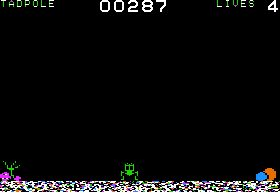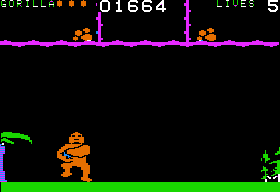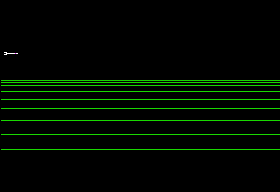Sydney Development Corp is a relatively obscure Canadian developer, not even having their own Wikipedia page, and now known mainly for their collaborations with Sierra On-Line and cartoonist Johnny Hart.
For
this post, which is likely the only time I'll discuss the company at
all, I played their first two games. The first is 1982's Evolution,
a self-published collection of six speciation-themed minigames with
about as much devotion to accuracy as Pokémon. This take on orthogenesis
ties in nicely to the source material of their second and most famous title, published by
Sierra in 1983: B.C.'s Quest for Tires.
Game 267: Evolution
The premise behind Evolution immediately makes me think of Maxis' 2008 title Spore, in which you evolve a single-celled creature into a complex life form through a series of arcade-style minigames and then develop a tribal society into a space faring empire. It's obviously far simpler, and lacks any kind of strategy phase or creature customization, but there are still enough parallels that I have to wonder if Will Wright played it back in the day.
Going by Mobygames release dates, Evolution was likely made first on Apple II, and ported in-house to ColecoVision, Commodore 64, and PC in 1983. I expect the Commodore 64 and ColecoVision ports to be more capable, but we do originals when possible here.
Starting off, there's a riff on Donkey Kong.
 |
| These are all modern species! |
Stage one has you control a single-celled organism, scooping up
pellets while avoiding predators in what seems to be inspired by
Pac-Man, though without any maze it more resembles Williams' Bubbles.
Loose controls and sloppy collision detection, two themes we'll see a lot throughout this post, plague this stage, but overall it's fairly easy. Pressing the joystick button activates a shield at the cost of some energy.
Biology nitpick: They didn't even spell "amoeba" right! And
although amoebas diversified hundreds of millions of years ago,
amoeboids only evolved into other amoeboids. Multicellular life has an
entirely different ancestor.
In the next phase you play an amphibian and must catch flies while avoiding fish.
This one's pretty frustrating. Randomly moving flies take some luck to catch, and this isn't helped by your slow-moving frog and poor hit detection. Avoiding the fish as they descend is easy enough, but then you've got to either jump over them or wait for them to surface, and you can get eaten if you try to jump over one and it suddenly rises mid-jump.
Biology nitpick: Are we a tadpole or a frog? If this is
underwater, why can't we swim? And how are the flies flying underwater? I
don't think these are supposed to be diving flies.
Stage 3 is rodents, in a Dig Dug-like game.
Digging slows you down, but if you can carve out a stable loop then
it's pretty easy to not get eaten by the snakes as you just run around
and collect cheese until the level ends. In a pinch, you can leave up to
three mouse droppings, which are fatal to snakes.
Biology nitpick: If humans haven't evolved yet, how can there be cheese?
Next there's a Frogger inspired game of building a beaver's dam.
This is probably the best minigame. It's basic, but it works. The alligators' movements are hard to predict, sometimes some of them follow your latitude, sometimes they move randomly, and sometimes they move in patterns. You can't count on manipulating their paths to create openings, so you've got to slip between them while you can.
Biology nitpick: It's pretty uncommon for alligators to prey on beavers. Lucky thing for the beavers, because gators swim much faster.
In stage five, you control a gorilla and throw rocks at monkeys trying to steal your stash of oranges.
Once again, poor collision detection makes this frustrating. But you've only got to nail five monkeys to end this round, so at least it's over fast.
Biology nitpick: Oranges are indigenous to the Indochinese Peninsula. Before human cultivation, native monkeys ate oranges, but gorillas didn't.
Finally, there's the human stage, a Berzerk-inspired shoot'em up where mutants threaten to kill the human race.
This
is the second best game, and though the controls are choppy and the
gameplay slow, the collision detection is shockingly good compared to
what came before it.
Biology nitpick:
Mutation is integral to Darwinian evolution. "Mutants" wouldn't so much
murder the human race with lasers as they would outcompete and outlive
us and become the game's next phase.
Kill all the mutants and you're rewarded with a beeper rendition of Gonna Fly Now and an ending cinematic.
Then you are returned to the amoeba phase and repeat the whole process on a harder difficulty.
GAB rating: Bad. I was never a huge fan of these minigame compilations. Sometimes they manage to be more than the sum of their parts, but this isn't one of them, and these parts range from poor to barely tolerable.
Game 268: B.C.'s Quest for Tires
A video game adaptation of Johnny Hart's long running comic strip B.C., this is best described as an early runner platformer in which you neither play as B.C. nor are you searching for tires.
B.C.
was simultaneously released for Atari computers and ColecoVision, and
shortly after released for the Apple II, Commodore 64, and IBM PC. In my
post about Venture, an anonymous commenter mentioned that ColecoVision
is likely the original target platform, as the Atari and Commodore
versions are credited to Sierra's Chuck Benton (the author of Softporn
Adventure!), rather than a Sydney Development employee. This is the
version I'll be playing.
Gameplay is reminiscent of Irem's Moon Patrol, but with a bigger focus on set pieces. As caveman Thor, you ride your stone unicycle through nine distinct stages, dodging and jumping over hazards until you reach Cute Chick, who's being held inside a cave by a dinosaur.
It features four difficulty levels, typical of ColecoVision games, but the best I could do was to beat level 2, which is in the above video.
The first stage just has you hopping over pits and rocks. You can control your speed, and the faster you go, the farther you jump, which you can extend by moving mid-jump. 40 seems like a good balance; go slower and the timing is stricter, go faster and the time you've got to react is shorter. You do need to jump sooner than you think; the pits in particular are wider than they look.
Next you have to duck under branches and jump over logs. I hate this part - the branches don't even look like they're part of the foreground and it's hard to tell exactly where the hitboxes are and where you need to duck to pass them, and the logs are almost invisible to my color-deficient eyes. I don't know if they pose a difficulty to true trichromats, but I have to focus on the grass really hard to even notice them, which is impossible when there are lots of branches.
The third challenge is Fat Broad, who will try to club you as you cross her turtle bridge. This is pretty easy on difficulty level 2, as the second turtle never submerges. You can just wait there until it's safe to jump to the third.
Next you cycle uphill a volcano, jumping over pits and rocks, just like before, only uphill, and with the occasional rolling rock.
At the top of the volcano, there's more stuff to jump over, but you also need to chase Dooky Bird and match his speed so you can catch a ride over the mouth. You don't want to be going too fast as you enter this stage, as Dooky Bird will come in faster than you.
Going downhill, I found that sometimes moving laterally mid-air works, but sometimes it doesn't, so it's best not to try. The pits are deceptively wide here; get anywhere near the edge of one and you die. Jump early instead. Keep your speed up here, not just because it makes jumping over the pits easier, but you'll need the speed to make the leap at the end.
I got robbed of a life here because the game buffered my jump input as it transitioned to the chasm, making me jump way too early. At least this is the funniest death animation in the game.
Beware falling rocks! The trick here is to slow down. The slower you ride, the slower the rocks fall.
Another turtle bridge, this time guarded by a happy dinosaur. This time, the turtles sink, but the dinosaur isn't as much of a problem as Fat Broad.
Finally, you race through a cave, jumping over stalagmites and ducking under stalactites. It's very easy, and Cute Chick waits for you at the end.
The game then repeats on the next difficulty, where obstacles are more frequent and your minimum speed is higher, but I couldn't get past Fat Broad on this level. Here, the second turtle does sink, and after several failed attempts to get through, I gave up.
GAB rating: Below Average. It's an improvement over Evolution, but I didn't have a good time. The controls and collision detection are inconsistent, the graphics are ugly, and like that other ColecoVision whale Smurf Rescue, there's just so little to see here - there's more variety and challenge, but it still only takes five minutes to see everything.
In 1984, Sydney Development had their most productive year, releasing the following:
- River Raid, ported to ColecoVision
- B.C. II: Grog's Revenge
- WizType & WizMath, based on Hart's Wizard of Id comic strip, also released through Sierra
- The Dam Busters, initially for Coleco's ill-fated Adam personal computer, then ported to ColecoVision and other platforms
Afterward,
in 1985, they released their last two games, Desert Fox and Fight
Night, both of which were initially published for the Commodore 64 in
the UK by U.S. Gold. Sydney Development just sort of disappears from
history after this point.
Designers Rick Banks and MaryLou
O'Rourke joined (founded?) development house Artech Studios in 1986,
whose first game was Killed Until Dead, and Banks has many credits to
his name with Artech, but O'Rourke's rap sheet just stops there.




























I live in the shadow of Vancouver, Canada, and a decade and change ago the local free weekly of record ran a feature on our local video game development ecosystem, fingering this company as the spark that got it all started: https://www.straight.com/article-198534/video-game-family-tree
ReplyDeleteThat's a pretty notable pedigree for a company that hasn't even got its own Wikipedia page!
DeleteHow do you choose the order you play the games in (aside from the year)? It's not alphabetical and AFAIK there aren't good enough release date records in this era to actually make a fine-tuned chronology. Is it just arbitrary?
ReplyDeleteBest-guess chronological, and then alphabetical. AFAIK, Archon, Spy Hunter, and Space Shuttle are November releases, while 10-Yard Fight and the several following ones are December. Games where the month is completely unknown come last. Sometimes there's order fudging - for instance, I did Reach for the Stars ahead of schedule because I wanted to cover SSI before M.U.L.E., and I delayed Archon until I could find time to play with a friend.
DeleteAh ! Evolution was a game from my infancy I had totally forgotten - and I only remember it ever existed with your blogpost.
ReplyDeleteI don't remember I ever passed the ape level, so it is the first time I see the human level.